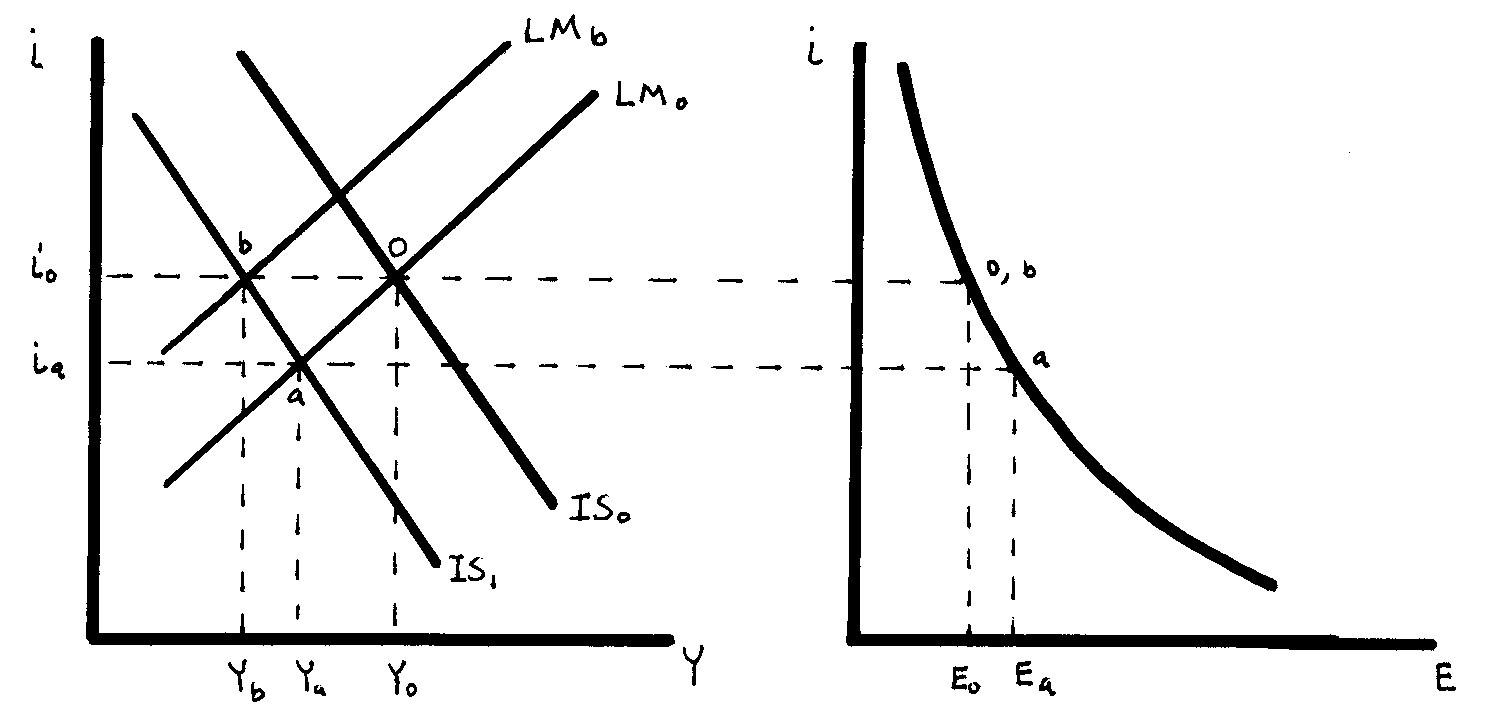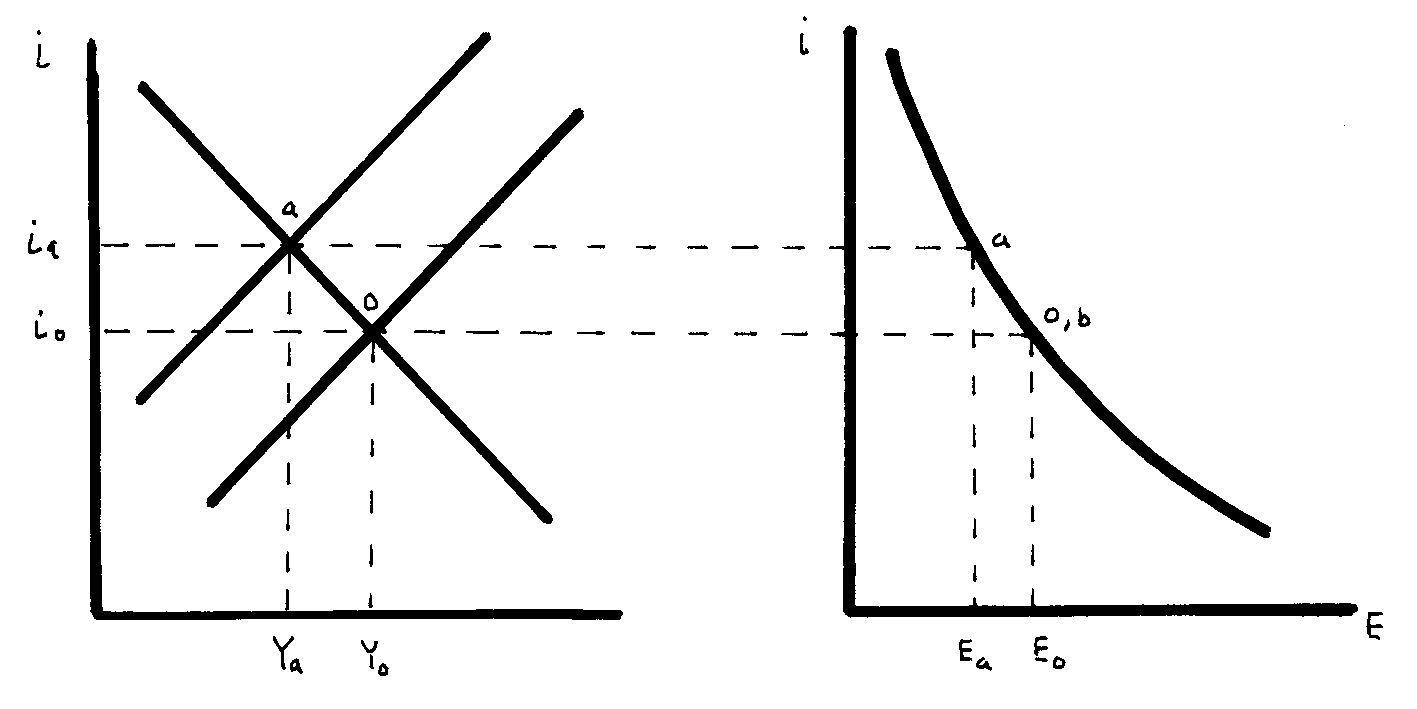PROBLEM SET 4 - INTERNATIONAL
- ANSWERS
1. a. The formula for the real exchange rate is e
= EP*/P. In this problem: P* = 1.2; E = 1/5
= .2, and P = 1.5, so
b. Now, E = 1/8 = .125, so e
= (1.2)(.125)/1.5 = .10
2. The interest parity condition tells us that
it .
i*t + (Eet+1 - Et)/Et
With it = 4%, and i*t = 6%,
then (Eet+1 - Et)/Et has to
be -2%. This means that the dollar price of the German mark is expected
to decline by 2%. This is an appreciation of the dollar.
3. The interest parity condition tells us that
it .
i*t + (Eet+1 - Et)/Et
With i*t = 20% and (Eet+1
- Et)/Et = 15%, US interest rates should be 5%. Since
you think that the return to holding Brazilian bonds is 5% higher than
everyone else thinks it is (because you think that there will be less depreciation
of the Brazilian currency, you should invest in Brazil.
4. a. To find equilibrium income set Z (total
demand for goods and services) equal to Y and solve for Y
Y = Z = c0 + c1 (Y - T)
+ d0 + d1 Y - d2 r + G0 - q1
Y + x1 Y*
now collect all the terms involving Y on the left-hand
side
Y - c1 Y - d1 Y + q1
Y = c0 - c1 T + d0 - d2 r +
G0 + x1 Y*
solving for Y yields:
Y = 1/(1 - c1 - d1 + q1)
[c0 - c1 T + d0 - d2 r + G0
+ x1 Y*]
b. The multiplier for a D
G is 1/(1 - c1 - d1 + q1).
c. The multiplier for a D
Y* is x1/(1 - c1 - d1 + q1).
5. The formula for net exports (exports minus
imports) is:
If there is a change in taxes, the resulting change
in income would be
D Y = [-c1/(1
- c1 - d1 + q1)] D
T.
The effect of this change in income on net exports
would all come through the imports side, yielding
D NX = [q1
c1/(1 - c1 - d1 + q1)] D
T,
which represents an increase in net imports.
6. To get an IS curve in this instance take the
equation for equilibrium income derived in question 4 part a, and solve
it for r, the variable on the vertical axis in the r,Y (IS-LM) plane. To
do this first isolate the term for r:
Y = 1/(1 - c1 - d1 + q1)
[c0 - c1 T + d0 + G0 + x1
Y*]
- [d2
/(1 - c1 - d1 + q1)]r
Now solve for r yielding
r = 1/d2 [c0 - c1
T + d0 + G0 + x1 Y*] - [(1 - c1
- d1 + q1)/d2 ] Y
Now we can say that
a. changes in x1 have no effect on
the slope of the IS curve,
b. an increase in q1 would cause the
IS curve to be steeper (the slope becomes larger in absolute value, therefore
the D r for a D
Y will be larger, i.e. the curve becomes steeper.)
7. The diagram shows the effects of a tax increase
under both flexible and fixed exchange rates.

The increase in taxes shifts the IS curve
to the left.
a. Under flexible exchange rates this shift in
the IS curve leads to a new equilibrium at point a, and income contracts,
interest rates fall, and the exchange rate rises. Under fixed
b. Under fixed exchange rates, the monetary authority
has to respond with a cut in the money supply shifting the LM curve up
until the change in interest rates and exchange rates disappears. This
leads to an equilibrium at point b, and a large fall in income.
8. The diagram shows the effects of a decrease
in the money supply under both flexible and fixed exchange rates.

The decrease in the money supply shifts
the LM curve up.
a. Under flexible exchange rates this shift in
the LM curve leads to a new equilibrium at point a, and income contracts,
interest rates rise, and the exchange rate falls.
b. Under fixed exchange rates, the monetary authority
has to undo the change in the money supply, because it has to undo the
change in the exchange rate. This means that equilibrium position of the
economy is unchanged, i.e. it returns to point 0.
9. Start out by setting up the three equilibrium
conditions:
Equilibrium in the Goods Market
(1) Y = 100 +.80 (1-.25) Y + 300 -1,000 i + 200
+ 195 - .1 Y + 100 E
[note: This is just Y = C + I + G + NX]
Equilibrium in the Money Market
(2) 800 = .8 Y - 2,000 i
[note: This is money supply equals money demand.]
Interest Parity Condition
next substitute (3) for E in (1), and simplify slightly,
yielding
(4) Y = 100 + .6 Y + 300 - 1,000 i + 200 + 45
- .1 Y + 100 (.75 - 5 i)
and simplify
(5) Y = 720 +.5 Y - 1,500 i.
now solve equation (2) for i, yielding
now substitute (6) into (5), yielding
(7) Y = 720 + .5 Y - 1,500 (-.4 + .0004 Y)
simplifying yields
(8) Y = 720 + .5 Y + 600 - .6 Y
Y = 1320 - .1
Y
which solves for Y as
Next substitute equation (9) into (6) to find the
equilibrium interest rate
(10) i = -.4 + .0004 (1200) = .08
Finally substitute equation (10) into equation (3)
yields
(11) E = .75 - 5 (.08) = .35
10. To calculate the effect of the change in I0
(the autonomous portion of investment) it is easiest to break into the
derivation of equilibrium income at equation (8) in the answer to question
9. Equation (8) would become
(8)' Y = 1320 + 110 - .1 Y
which solves for Y as
This shows us that the D
Y = 100.
Now using the results from question 4, the relevant
multiplier for a D
I0 is the multiplier derived for a D
G, i.e.
Using the numbers from the model in problem 9, we
find that
c1 = .8(1-.25) (note we have to add
the tax rate here), d1 = 0, and q1 = .1.
The multiplier would be:
1/(1 - .6 + .1) = 1/(.5) = 2.0
The reason that the actual change in Y which we calculated
is lower than this multiplier suggests it should be is that we have a full
IS-LM model in question 9, and only an IS curve in question 4's model.
The multiplier of 2.0 would tell us how far the IS curve shifted to the
right, but (since this does not take into consideration either the effects
in the money market or the effects of exchange rate changes on net exports,
it overestimates the change in income.


